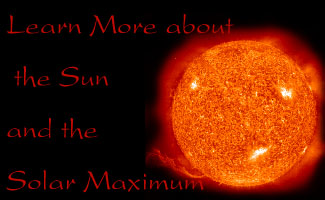
The Sun, a roiling ball of plasma, occupies its place in space approximately 93 million miles from Earth. Though it seems simple to inhabitants of this planet -- the Sun shines, giving light and heat -- the processes occurring in the Sun are so complex that many scientists devote their careers to just one aspect of solar activity.
Changes in the activity of the Sun particularly engage solar scientists. Whether fluctuations in the solar magnetic field, expulsions of plasma called coronal mass ejections, emissions of high-energy flares, or changes in the sunspot number, variations in solar activity can be dramatic and therefore highly interesting.
Through careful study of solar activity (particularly sunspots, visible from Earth through telescopes) over hundreds of years, scientists have found a consistent cycle of activity: every eleven years, activity rises to a maximum, then falls to a minimum. To track the solar cycle, scientists plot the average of Wolf numbers (values from a method of counting sunspots devised by Johann Rudolf Wolf in 1848) from various observatories daily to get a sunspot number graph.
The sunspot or solar cycle does not have the same magnitude every eleven years, however. Entire cycles can have lower activity levels than usual, as during the Maunder Minimum from 1645 to 1700, or the upcoming maximum might have more activity than ever. A look at the sunspot plot for the last two centuries will show the fluctuation in minima and maxima.
Solar maximum, the peak of solar activity, occurs, according to the latest predictions, in the year 2000. Scientists expect to see increased activity from sunspots to flares, and the public can expect to see more solar effects at Earth (like magnetic storms and aurora) and more news pieces on the subject over the next few years.
For more details about the Sun and its cycle, follow the links below.
More about the Solar Cycle
-
The Changing Solar Wind
Windows to the Universe compares fluctuations in different types of solar activity to the solar cycle. -
Dr. SOHO's FAQ: Questions about Sunspots
Another of Dr. SOHO's detailed question pages, this page gives good information and links relating to sunspots and the solar maximum. -
Solar Cycle (Oulu)
A Finnish textbook defines the characteristics of the solar cycle. -
The Solar Cycle (Scibernet)
This site contains multiple pages on the solar cycle, with equations and graphics. -
Solar Cycle (WtU)
An explanation of the solar cycle from Windows to the Universe. -
Sunspots
This site, all about sunspots, discusses them and gives history, related research, activities, and a glossary. -
Sunspots and the Solar Cycle
Maintained by the National Solar Observatory at Sacramento Peak, this page contains detailed information on nearly every aspect of the solar cycle. -
Sunspotcycle.Com
This student-oriented page has brief descriptions of the solar cycle and its effects on Earth, but its real value is in its links to other good resources. -
SolarMax2000.Com
A page of links to information and images about the 2000 solar maximum. -
What is the Sunspot Number?
Gives a brief description of how scientists calculate the sunspot number every day.
More about the Solar Cycle's Effects
-
Observing Sun-Earth Connections
A discussion of the upcoming solar maximum and how the ISTP constellation of satellites will observe it. -
Readiness for the Upcoming Solar Maximum
A report on the science of the upcoming solar maximum and how ready government agencies will be to receive it. -
Storms in Space
Discusses one of the results of increased solar activity: more magnetic storms. -
Sun Causes Space Weather
A page of Sun-Earth connections with some information on the solar cycle and many good pictures. -
Sun-Earth Connection
A detailed page from the National Solar Observatory at Sacramento Peak on the effects of solar activity on Earth.
More about the Last Solar Maximum
-
Blackout -- Massive Power Grid Failure
This Windows to the Universe page discusses the HydroQuebec power failure during a storm of the last solar maximum. -
Damage from Space Weather
Gives statistics on the effects of the March 1989 (solar maximum) magnetic storm. -
Disturbed Aurora
The image on this page shows the effect of the March 1989 magnetic storm on the aurora, as observed by the Dynamics Explorer spacecraft. -
How Much Does a Solar Storm Cost?
The huge cost of blackouts shown on this page to companies and customers makes prediction of solar maximum conditions important. -
3 Problems in Restoring Power
As if a blackout alone were not bad enough -- this page details how getting power back to customers after a solar maximum power failure can be even worse.
More about the Sun
-
Dr. SOHO's FAQ: Questions about the Sun
If you have any question at all about the Sun, from the missing-neutrino mystery to the date of the next solar eclipse, Dr. SOHO probably has the answer or knows someone who does. -
Our Changing Sun
Explains the various parts and features of the Sun, such as prominences, flares, and the corona. -
Space Weather Center: Questions and Answers
This page deals with space weather and solar cycle questions, too, but it contains basic information about the Sun in its first half. -
The Sun: A Pictorial Introduction
This slide set has very detailed information about the Sun -- slides 17, 18, 10, and the conclusion deal specifically with the solar maximum.
Brought to you by the International Solar-Terrestrial Physics Program and NASA.
Web Design and Development: Theresa Valentine
Last Modified: 8/3/00
 |
||||||||||||
